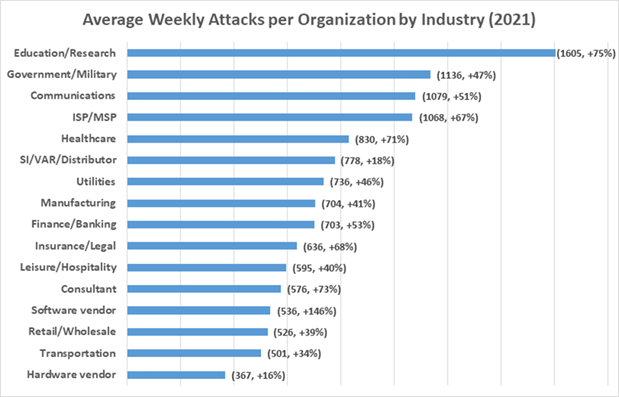With the beginning of the new year, η Check Point Research (CPR) presents global statistics data on the growth of cyber attacks as observed in 2021 by region, country and industry.
Last year, CPR saw a 50% increase in cyber-attacks per week on corporate networks compared to 2020, culminating in December, mainly due to Log4J holdings. Hackers targeted Africa, Asia and Latin America more, but Europe saw the largest percentage increase in cyber attacks compared to last year.
The field of education/researchs was the one that took first place as the most targeted industry worldwide.
- Cyber-attacks in education / research increased by 75% last year
- Cyber-attacks on government sector increased by 47% last year
- Cyber-attacks in healthcare increased by 71% last year
Check Point Research (CPR), the research unit of Check Point Software, reports that the trend of increasing cyber attacks reached the highest point of all time at the end of 2021 after the revelation of the Log4J vulnerability, reaching 925 cyber attacks per week per organization, in global level.
The most targeted areas by hackers in 2021 worldwide
- Education / Research (+ 75%)
- Government / Army (+ 47%)
- Communications (+ 51%)
- ISP / MSP (67%)
- Health (71%)
More targeted areas
- Africa (+ 13%)
- Asia-Pacific (+ 25%)
- Latin America (+ 38%)
- Europe (+ 68%)
- North America (+ 61%)

Comment by Omer Dembinsky, Data Research Manager at Check Point Software:
"Hackers continue to innovate. Last year, we saw an impressive 50% more cyber attacks per week on corporate networks compared to 2020, this is a significant increase. We have seen the number of cyberattacks peak towards the end of the year, mainly due to vulnerability exploitation efforts. log4J. New penetration techniques and avoidance methods have made it much easier for hackers to carry out malicious intent. The most worrying thing is that we see some key social sectors being launched into the list of most attacked. The education, government and healthcare sectors are on the list of the 5 most attacked industries in the world. I expect these numbers to increase in the run-up to 2022, as hackers continue to innovate and find new methods of carrying out cyber attacks, in particular ransomware. We are facing a cyber pandemic. I strongly urge the public, especially those working in the fields of education, government and healthcare, to learn the basics of how to protect themselves. "Simple measures such as repairing, segmenting networks and educating employees can go a long way in making the world safer."
Security tips
- Prevention, not detection
- Insure everything
- You repair often
- Fragment your networks
- Educate your employees
- Apply advanced security technologies
______________________
*Statistics and data used in this report present data detected by Check Point's threat prevention technologies, stored and analyzed in ThreatCloud. ThreatCloud provides information για απειλές σε πραγματικό χρόνο που προέρχονται από εκατοντάδες εκατομμύρια αισθητήρες παγκοσμίως, σε δίκτυα, τελικά σημεία και κινητά τηλέφωνα. Το ThreatCloud είναι στην πραγματικότητα η κινητήριος δύναμη πίσω από την ισχύ της Check Point Software για την πρόληψη απειλών, συνδυάζει την ευφυΐα όσον αφορά τις απειλές και τα big date με προηγμένες τεχνολογίες artificialof intelligence to provide accurate prevention to all Check Point Software customers.






